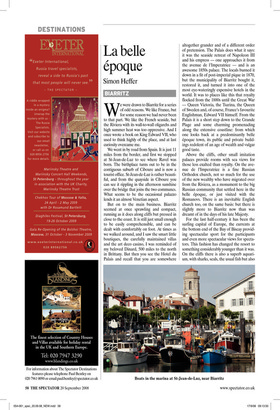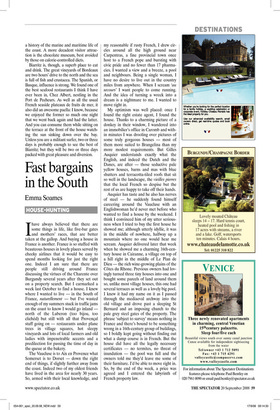La belle époque
Simon Heffer
BIARRITZ We were drawn to Biarritz for a series of odd reasons. We like France, but for some reason we had never been to that part. We like the French seaside, but the Riviera with its wall-to-wall oligarchs and high summer heat was too oppressive. And I once wrote a book on King Edward VII, who used to think highly of the place, and at last curiosity overcame me.
We went in by road from Spain. It is just 11 miles from the border, and first we stopped at St-Jean-de-Luz to see where Ravel was born. The birthplace turns out to be in the contiguous suburb of Ciboure and is now a tourist office. St-Jean-de-Luz is rather beautiful, and from the quayside in Ciboure you can see it rippling in the afternoon sunshine over the bridge that joins the two communes. What seems to be the occasional palazzo lends it an almost Venetian aspect.
But on to the main business. Biarritz seemed at once sprawling and compact, running as it does along cliffs but pressed in close to the coast. It is still just small enough to be easily comprehensible, and can be dealt with comfortably on foot. At times as we walked around, and I saw the smart little boutiques, the carefully maintained villas and the art deco casino, I was reminded of my beloved Dinard, 500 miles to the north in Brittany. But then you see the Hotel du Palais and recall that you are somewhere altogether grander and of a different order of pretension. The Palais does what it says: it was the seaside retreat of Napoleon III and his empress — one approaches it from the avenue de l’Imperatrice — and is an awesome 1850s palace. The locals burned it down in a fit of post-imperial pique in 1870, but the municipality of Biarritz bought it, restored it, and turned it into one of the most eye-wateringly expensive hotels in the world. It was to places like this that royalty flocked from the 1880s until the Great War — Queen Victoria, the Tsarina, the Queen of Sweden and, of course, France’s favourite Englishman, Edward VII himself. From the Palais it is a short step down to the Grande Plage and some charming promenading along the extensive coastline: from which one looks back at a predominantly belle époque town, its public and private buildings redolent of an age of wealth and vulgar good taste.
Above the cliffs, other small imitation palaces provide rooms with sea views for those less exalted than royalty. On the avenue de l’Imperatrice is a fine Russian Orthodox church, not so much for the use of the new wealthy who have migrated over from the Riviera, as a monument to the big Russian community that settled here in the belle époque, or just visited with the Romanovs. There is an inevitable English church too, on the same basis: but there is slightly more to Biarritz now than was dreamt of in the days of his late Majesty.
For the last half-century it has been the surfing capital of Europe, the currents at the bottom end of the Bay of Biscay providing spectacular sport for the participants and even more spectacular views for spectators. This fashion has changed the resort to something considerably younger than it was. On the cliffs there is also a superb aquarium, with sharks, seals, the usual fish but also a history of the marine and maritime life of the coast. A more decadent visitor attraction is the chocolate museum, best avoided by those on calorie-controlled diets.
Biarritz is, though, a superb place to eat and drink. The great vineyards of Bordeaux are two hours’ drive to the north and the sea is full of fish and crustacea. The Spanish, or Basque, influence is strong. We found one of the best seafood restaurants I think I have ever been in, Chez Albert, nestling in the Port de Pecheurs. As well as all the usual French seaside plateaux de fruits de mer, it also did an awesome paella: I know, because we enjoyed the former so much one night that we went back again and had the latter. And you can consume them while sitting on the terrace at the front of the house watching the sun sinking down over the bay. Unless you are a militant surfer, two or three days is probably enough to see the best of Biarritz; but they will be two or three days packed with great pleasure and diversion.











































































 Previous page
Previous page